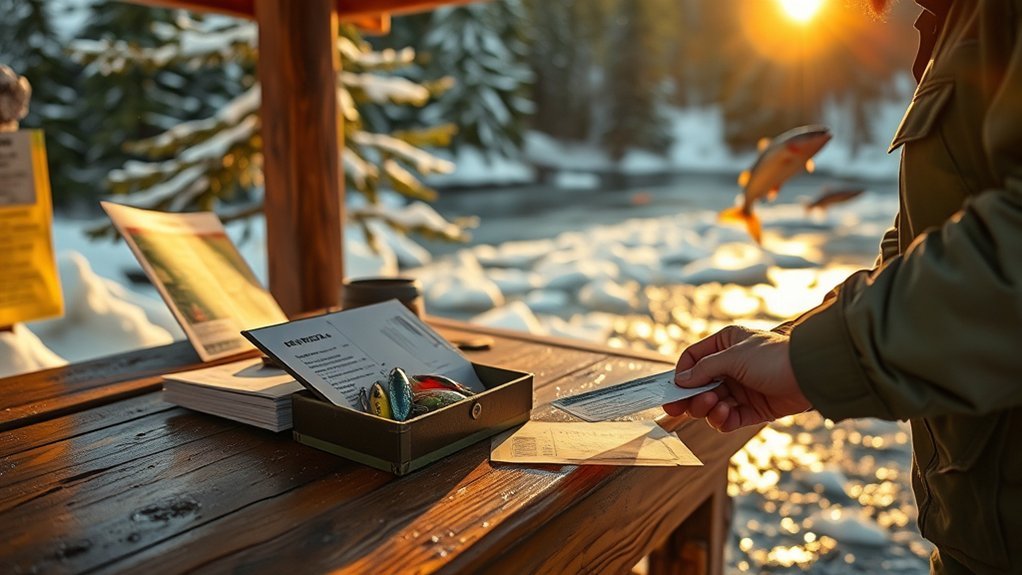If you’re fishing in Alaska for a week, non‑residents must buy a 7‑day license for $70 and residents pay $30; children 15 and under don’t need a license and residents must be 18 to buy short‑term permits. Licenses are valid seven consecutive days, must be carried with ID, and species‑specific rules (like King Salmon stamps) may add fees or permits. Buy online, at ADF&G offices, or many sporting stores — continue for details on stamps, formats, and exemptions.
Who Needs a 7-Day Fishing License in Alaska

Who needs a 7-day fishing license in Alaska?
You need one if you meet specific license eligibility criteria tied to residency and age. As a non-resident aged 16 or older, you must obtain a 7-day license to fish in fresh or salt waters during your visit.
Non-residents 16 and older must purchase a 7-day Alaska fishing license to fish fresh or salt waters.
If you’re a resident and choose a short-term option instead of an annual license, you must be at least 18 to purchase the 7-day permit.
Children 15 and under aren’t required to hold any fishing license, including the 7-day, but you still must follow catch limits and size restrictions on their behalf.
The 7-day license activates on purchase and remains valid for seven consecutive days, granting legal access to Alaska’s regulated fisheries.
Keep documentation or proof of residency and age with you while fishing to demonstrate compliance with fishing age requirements and the state’s license eligibility criteria.
Resident Vs Non‑Resident 7‑Day License Prices
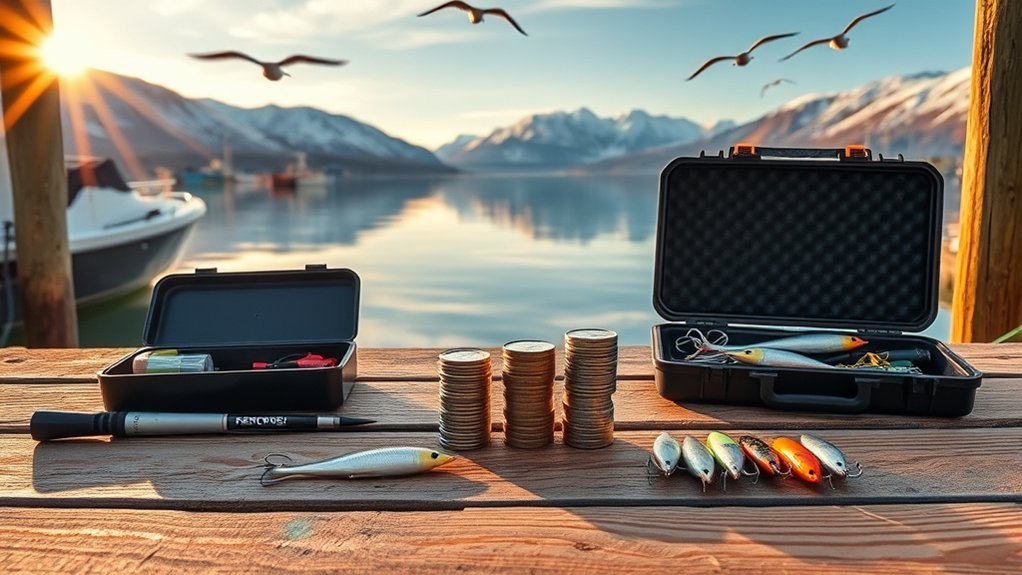
Alaska offers a short-term 7-day fishing license at two fixed rates: residents pay $30 and non‑residents pay $70. You’ll see a clear cost comparison between the two categories: the resident fee is less than half the non‑resident charge. That pricing difference reflects residency-based fee structures rather than differing access; both licenses permit fishing in all fresh and salt waters statewide.
When you buy a 7-day license, follow fishing regulations applicable to your residency status; fees don’t change based on experience or trip length within the seven days. You’ll choose the resident rate only if you meet residency criteria; otherwise you must pay the non‑resident rate.
The short-term option gives flexibility for brief visits or trials without committing to an annual license. For planning, use the fixed fees above to budget trips and compare costs against longer-term licenses when evaluating value under prevailing fishing regulations.
What the 7‑Day License Covers and Restrictions

With a 7-day license you can fish both fresh and salt waters statewide, and it generally covers a range of species including crabbing.
You still must meet species-specific requirements — for example, King Salmon often requires a separate stamp — and follow daily bag and size limits.
Carry your license while fishing and heed local regulations to avoid fines.
Covered Waters and Species
If you buy a 7‑day fishing license, it covers both freshwater and saltwater fishing statewide for that consecutive seven‑day period, but you must follow area‑specific regulations and species limits.
You can fish diverse fishing locations—rivers, lakes, estuaries, and coastal waters—but you’re bound by local closures, season dates, and gear restrictions.
The license allows targeting salmon, halibut, trout and other regulated species; you must use proper species identification to guarantee compliance with size and bag limits.
Harvest limits and size restrictions in Alaska Department of Fish and Game regulations apply per waterbody and species.
Note that retaining certain species may require additional permits; check current emergency orders and area regulations before you fish to avoid violations.
King Salmon Stamp Requirement
A 7‑day fishing license lets you fish freshwater and saltwater statewide for that consecutive period, but it doesn’t exempt you from the mandatory King Salmon Stamp when you fish for or retain king (Chinook) salmon; non‑resident stamps cost $15 for one day or $100 annually, and residents must also carry the stamp where required.
You must purchase the appropriate stamp in addition to the 7‑day license ($70 non‑resident, $30 resident) if you intend to fish for King Salmon. The King Salmon Stamp is mandatory for anyone fishing or retaining King Salmon regardless of license type.
Carry both your fishing license and stamp while fishing. Follow all Alaska Fishing Regulations: stamps, licenses, and posted area-specific rules determine lawful harvest and possession.
Daily Bag and Size Limits
Because daily bag and size limits change by species and area, you must check current local regulations before you fish under a 7‑day license.
The 7‑day license (non‑resident $70, resident $30) permits freshwater and saltwater sport fishing but doesn’t waive species‑specific rules such as the King Salmon Stamp requirement.
You must follow posted bag limits and size restrictions for each species and area; some species also have annual harvest limits that require recording catches on a Harvest Record Card during your license period.
Enforcement is strict: violating bag limits or size restrictions can result in fines or loss of privileges.
Before you fish, review the Alaska Department of Fish and Game emergency orders and area summaries to guarantee compliance.
King Salmon Stamp and Additional Fees
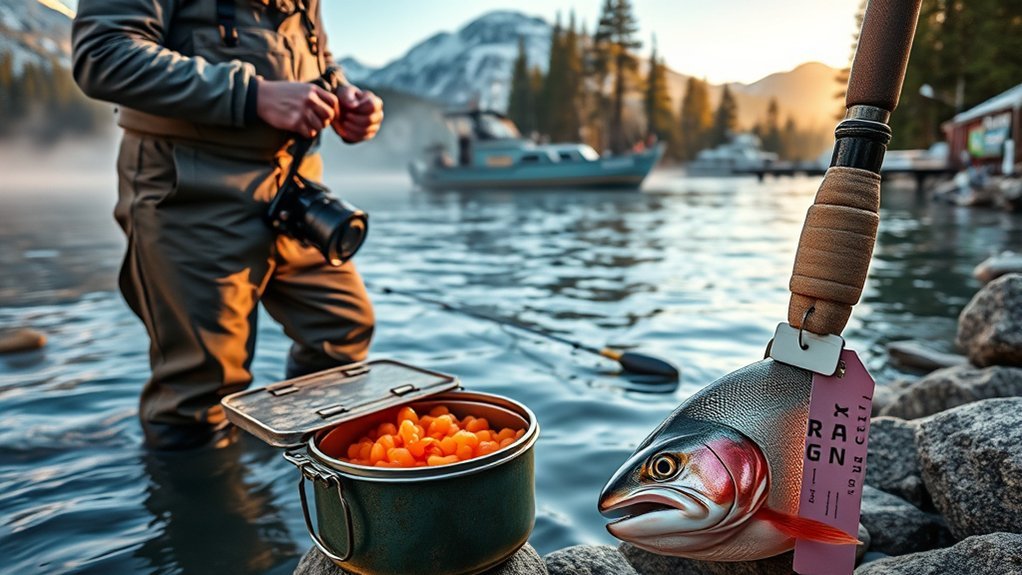
If you plan to fish for or retain King (Chinook) Salmon in Alaska, you must purchase a King Salmon Stamp with your fishing license.
Non-residents pay $15 for the stamp and residents pay $10, and the stamp is mandatory whenever you target King Salmon.
Failure to purchase the stamp can result in fines and other penalties, so include it when you buy your 7‑day license.
King Salmon Stamp Requirement
Wondering what extra paperwork you need to target King Salmon in Alaska? You must carry the King Salmon Stamp whenever you fish for or retain King Salmon; stamp enforcement is active and tied to fishing compliance checks.
Non-residents pay $15 for a 1-day stamp, $100 for an annual stamp, or $30 for a non-resident military annual stamp. Residents purchase a $10 stamp in addition to their fishing license.
The stamp is mandatory regardless of license duration and must be on you while fishing and used to record King Salmon on the Harvest Record Card.
Failure to have the required stamp can result in fines and other penalties during enforcement stops. Obtain and display the correct stamp to remain compliant.
Additional Stamp Costs
When planning a short trip, expect to pay both the 7-day sport fishing license and any required King Salmon Stamp: non-residents pay $70 for the 7-day license plus a $15 1-day King Salmon Stamp (or $100 for an annual non-resident stamp if you’ll retain King Salmon), while residents pay $30 for a 7-day license and a $10 King Salmon Stamp.
You’re responsible for stamp pricing beyond the base license; stamps authorize targeting or retaining King Salmon and don’t extend license validity. Purchase stamps with the license or before fishing. Keep receipts for enforcement.
- Confirm required stamps for species targeted
- Match stamp term to trip length
- Annual stamp mandatory if retaining fish
- Stamps don’t change license validity
- Carry proof of purchase on water
How to Purchase a 7‑Day Fishing License Online
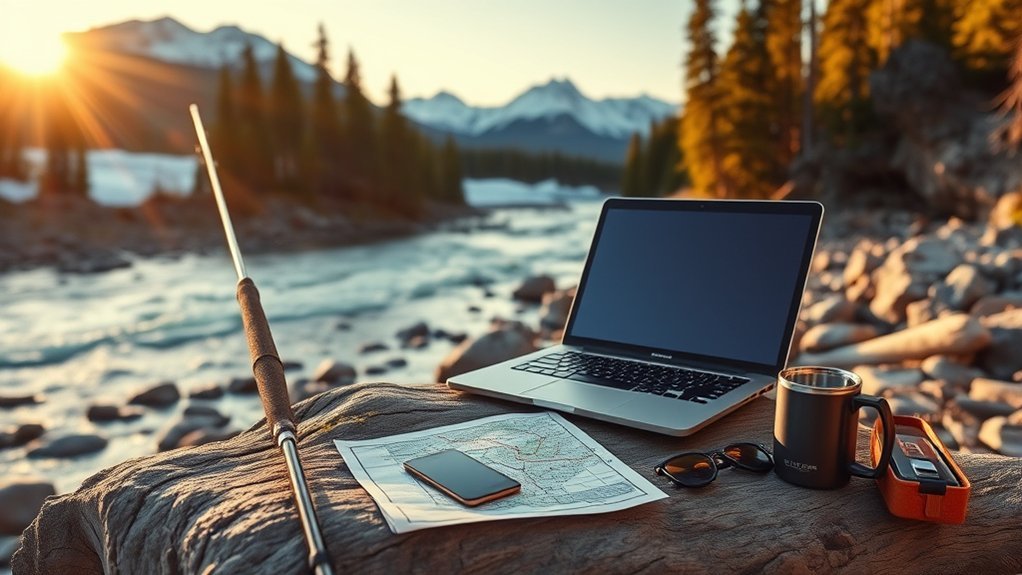
Want to buy a 7‑day Alaska fishing license online? Start at the Alaska Department of Fish and Game website and complete an online account setup.
Use license purchasing tips: have a valid ID (driver’s license or military ID) ready and choose resident or non‑resident pricing ($30 resident, $70 non‑resident).
After signing in, select the 7‑day fishing license option, confirm personal details, and proceed to payment. The system accepts credit or debit cards for instant approval.
Complete payment to finalize the transaction; you’ll be able to print your license immediately. Carry the printed license and your ID while fishing.
Keep records of your transaction number and receipt in case of questions. If you plan multiple future purchases, maintain your account credentials securely to expedite renewals.
Follow on‑site prompts precisely to avoid errors; the online process is immediate when you supply accurate identification and valid card information.
Where to Buy a 7‑Day License In Person in Alaska

You can buy a 7‑day fishing license in person at ADF&G offices, many sporting‑goods stores across Alaska, or through some charter operators that include the license in trip packages.
You’ll find clear buying options and official license locations statewide; non‑residents pay $70 and residents pay $30. Visit an ADF&G office for immediate issuance and regulatory guidance.
Retail vendors and charter services provide convenience when you’re traveling or booking a trip; confirm they issue 7‑day sport fishing licenses before relying on them.
- ADF&G offices: statewide, primary source for compliance and questions
- Sporting‑goods stores: common retail buying option in cities
- Charter operators: may include license cost in trip packages
- Confirm price: $70 non‑resident, $30 resident
- Bring proof of identity when purchasing
You’re responsible for selecting the appropriate buying options and verifying license locations before fishing to guarantee lawful participation.
License Formats, Printing, and Carrying Requirements

You can choose electronic/printed, eSigned, or carbon copy formats for your 7‑day license, with resident and nonresident fees applied at purchase.
Licenses must be bought and printed or otherwise accessible before you fish, and you’re required to carry the license while fishing to comply with regulations.
If you lose it, request a duplicate for $5.00 to avoid penalties.
Electronic vs. Printed
Although you can choose between electronic or printed formats for Alaska fishing licenses, you’re required to carry a physical copy while fishing and must present either format to enforcement officers on request.
You’ll appreciate electronic convenience for quick access and re‑access online; printed durability helps when devices fail or lack service.
Non‑residents pay $70 and residents $30 for the 7‑day license. If you lose a printed copy, you can purchase a duplicate for $5.
Both formats are equally valid; compliance is binary — have a license and show it when asked.
- Electronic convenience: access anytime online
- Printed durability: no battery or signal needed
- Duplicate printed copy available for $5
- Both formats must be presented on request
- Fees: $70 non‑resident, $30 resident
Carrying Your License
One clear rule: carry a printed copy of your Alaska fishing license and any required King Salmon stamp while fishing, because digital-only displays aren’t accepted. You must present the physical document on demand; electronic, eSigned, or carbon copy formats are acceptable only if printed.
Know which license types you hold (resident, non-resident 7-day) and keep proof of purchase accessible. If you lose your paper license, obtain a duplicate from the Alaska Department of Fish & Game for $5.00 before returning to the water.
Carrying the proper stamp when targeting King Salmon is mandatory in addition to your license. These carrying requirements support enforcement of fishing regulations; failure to comply can result in citations, so keep printed documentation with you at all times.
Exemptions and Special Licenses (Seniors, Low‑Income, Disabled)
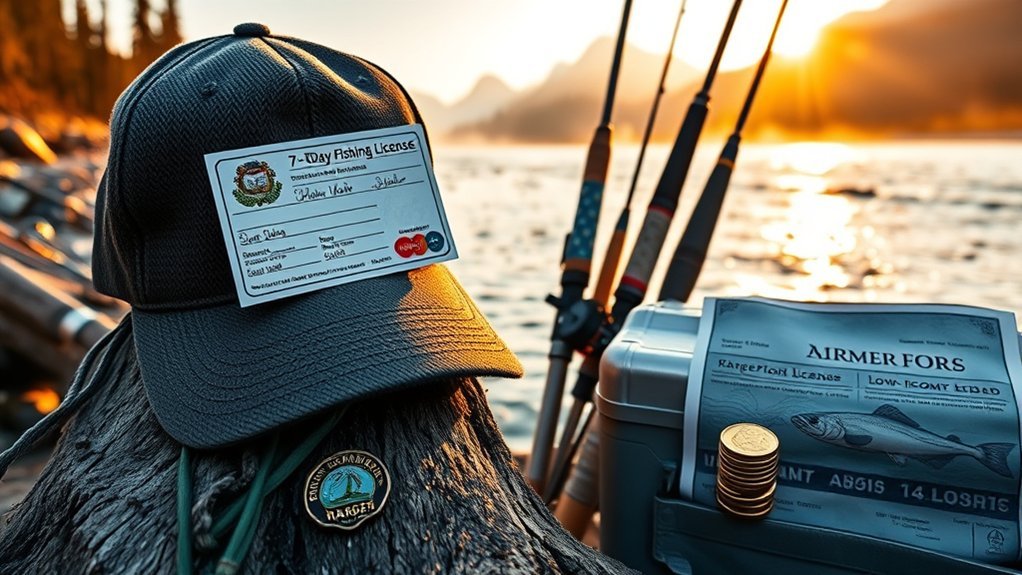
When you qualify under age, income, or disability criteria, Alaska provides several fee‑reducing or exempt options so eligible residents can fish without undue cost.
You can rely on clear, statutory pathways: senior exemptions let residents 60+ obtain a free ADF&G Permanent Senior ID Card that replaces a license; low income licenses let eligible residents buy a sport fishing license for $5.
Disabled veterans are eligible for a free sport fishing license; residents who are blind may obtain a sport fishing license for $0.50.
Special personal‑use and subsistence licenses are available only to Alaska residents and address particular household and cultural needs.
- Free ADF&G Permanent Senior ID Card for residents 60+
- $5 sport fishing license for qualifying low income residents
- Free sport fishing license for disabled veterans
- $0.50 sport fishing license for blind residents
- Personal‑use and subsistence licenses exclusive to Alaska residents
Confirm eligibility documentation and apply through ADF&G or authorized vendors to secure the appropriate exemption or special license.
Recordkeeping, Harvest Cards, and Reporting Requirements

After securing any exemptions or special licenses, you must follow Alaska’s recordkeeping and reporting rules to legally fish. You’re required to use proper recordkeeping practices: fill out a Harvest Record Card for every sport fish you catch if you’re 15 or younger, and you should complete one whenever regulations require tracking.
The harvest card importance is twofold: it documents each fish taken and helps you and ADF&G monitor compliance with seasonal and area-specific size and catch limits. All anglers, including minors, must obey those limits; detailed rules appear on ADF&G pages 20–21.
Maintain legible, accurate entries so you can demonstrate adherence to personal harvest limits during enforcement checks. If you fail to complete or retain required records or exceed limits, you risk penalties, including fines.
Keep cards accessible while fishing and submit or retain them as directed by ADF&G. Follow these steps precisely to avoid violations and support fishery management.
Tips for Planning a 7‑Day Fishing Trip in Alaska
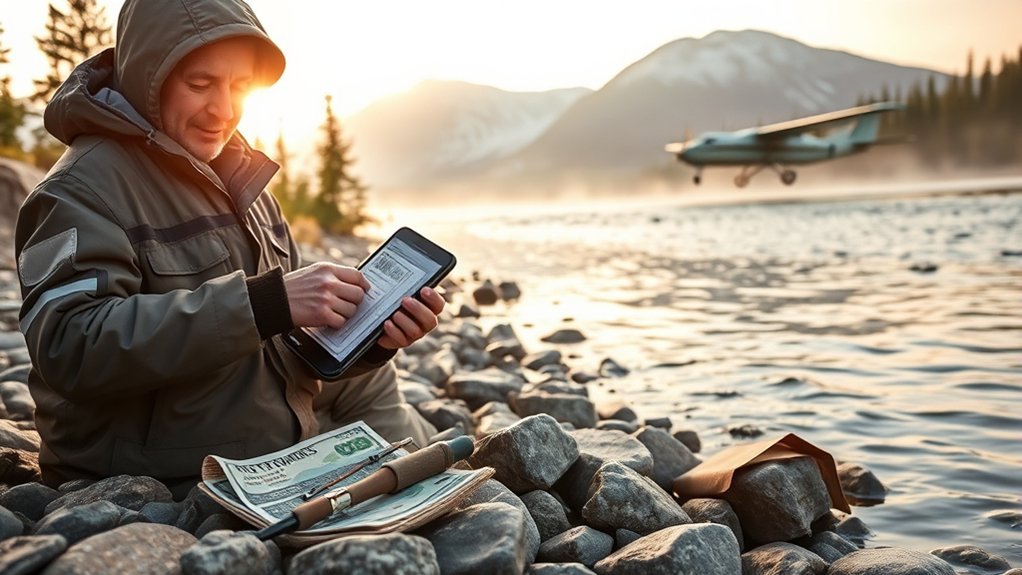
Although you can buy a 7‑day license for non‑residents ($70) or residents ($30), plan your trip around peak seasons (for example, King Salmon runs June–mid‑July).
Buy a 7‑day license (non‑residents $70, residents $30) and time your trip for peak runs—King Salmon June–mid‑July.
Confirm any required stamps (King Salmon stamp for targeting kings), and carry a Harvest Record Card if the fishery requires recording catches.
You’ll choose dates, waters, and services to meet regulations and maximize success.
Check area-specific closures, bag limits, gear rules, and reporting deadlines before departure. Use official resources for current emergency and regulation updates.
- Prioritize peak-season windows for target species.
- Research best fishing spots and applicable restrictions.
- Book local fishing guides for access and compliance.
- Secure necessary stamps and Harvest Record Card in advance.
- Prepare to log and report catches per fishery rules.
Pack safety gear, communications, and backup permits.
When you hire local fishing guides, confirm they follow current regs and provide documentation.
Keep records accessible for inspections and reporting.
Frequently Asked Questions
Can I Upgrade a 7-Day License to an Annual One Mid-Trip?
Yes — you can usually upgrade mid‑trip; initiate the license upgrade process online or through an Alaska licensing vendor. You’ll switch fishing license types, pay the difference, and your new annual permit becomes effective immediately.
Does the 7-Day License Cover Sportfishing From a Charter Boat?
Yes — your 7-day license covers sportfishing from a charter boat, provided you follow charter regulations and local fishing limits; you’re responsible for personal compliance, and the charter operator enforces vessel-specific rules and reporting requirements.
Are There Refunds if Bad Weather Cancels My Trip?
Like airlines promising safe passage, you’ll usually find no state refunds for weather cancellations; check charter refund policies and refund policies from vendors, because operators’ weather cancellations often govern reimbursements and regulatory exceptions.
Do Youth Under a Certain Age Need Any License at All?
Yes — you’re often exempt: youth fishing regulations typically waive license requirements for children under a specific age, though age exemptions vary by state and species; always verify local regulations and carry ID proving the child’s age.
Is Shore-Based Saltwater Fishing Included in the 7-Day License?
Yes — the 7-day license covers shore-based saltwater fishing; you’re expected to follow shore fishing regulations, report and harvest saltwater species within bag, size, and season limits, and carry required ID or permits while fishing.
Conclusion
You’ll want that 7‑day license nailed down before you hit Alaska’s waters — it’s legally required, not optional. One wrong assumption about residency, king salmon stamps, or harvest cards can blow your trip faster than a gale. Buy online, carry the printed or digital copy, and follow reporting rules to avoid fines. Plan fees, limits, and exemptions ahead so you’re focused on fishing, not paperwork, during every single frantic, glorious Alaska day.

